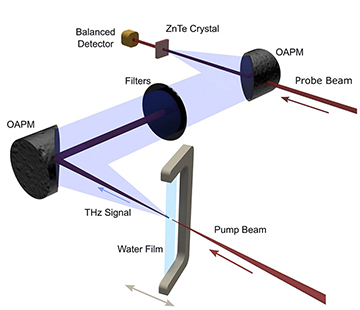![]()
Researchers have used lasers to generate terahertz pulses via interaction with a target—in this case, an extremely thin film of water. The nearly 200-μm-thick water film is suspended between two aluminum wires. [Image: Kaia Williams and Brandon Dube, University of Rochester]
Scientists have generated terahertz waves from solids, plasmas and even water vapor—but, until now, not from liquid water, which strongly absorbs radiation in that frequency range. Researchers at a U.S. university have finally figured out the right setup for generating broadband terahertz radiation from liquid water excited by femtosecond laser pulses (Appl. Phys. Lett., doi:10.1063/1.4990824).
Key to this feat is the geometry of the experimental setup: focusing the laser on a free-flowing water film just 177 ± 8 μm thick. Optics doctoral candidate Qi Jin and his colleagues in OSA Fellow Xi-Cheng Zhang’s group at the University of Rochester confirmed that the terahertz radiation was actually coming from the water, not the surrounding air, and explored the dependence of the polarization of the emission on the polarization of the pump beam.
To get a consistent and stable film, Jin’s team set up a gravity-driven flow of water between two horizontal aluminum wires. Adjustments to the flow rate controlled the thickness of the vertical sheet of water. In that plane, the researchers focused a polarized beam from an 800-nm-wavelength pump laser with a repetition rate of 1 kHz.

Experimental setup used to generate terahertz radiation from liquid water. Researchers focus the optical pump beam into the water film and use filters, off-axis parabolic mirrors (OAPMs) and other optical components to detect the terahertz signal and block any other light waves simultaneously generated from the water film.
Between each laser pulse, the water flowed about 1.3 mm—a much greater distance than the width of the light beam’s focal spot. According to the authors, this ensured that each light pulse would interact with water that had not previously interacted with the beam. To confirm that the terahertz emission was coming from the water and not the surrounding air, the team moved the water film in and out of the beam’s focal spot in the direction of the laser propagation and measured the terahertz fields in the various positions.
Zhang says that many people with whom he discussed the idea for generating terahertz emission from water had reservations about the project, because water’s large absorption coefficient in that frequency range is well known. Several of his students had taken stabs at the idea, but they gave up after a few tries, until Jin came along and incorporated recent studies of free-space water films into the work.
In the future, Zhang would like to study water-laser interactions at Rochester’s Laboratory for Laser Energetics (LLE), the second largest laser-fusion facility in the United States. In the meantime, he’s pleased that the last piece of the puzzle—terahertz generation from all four states of matter—has been put into place.
